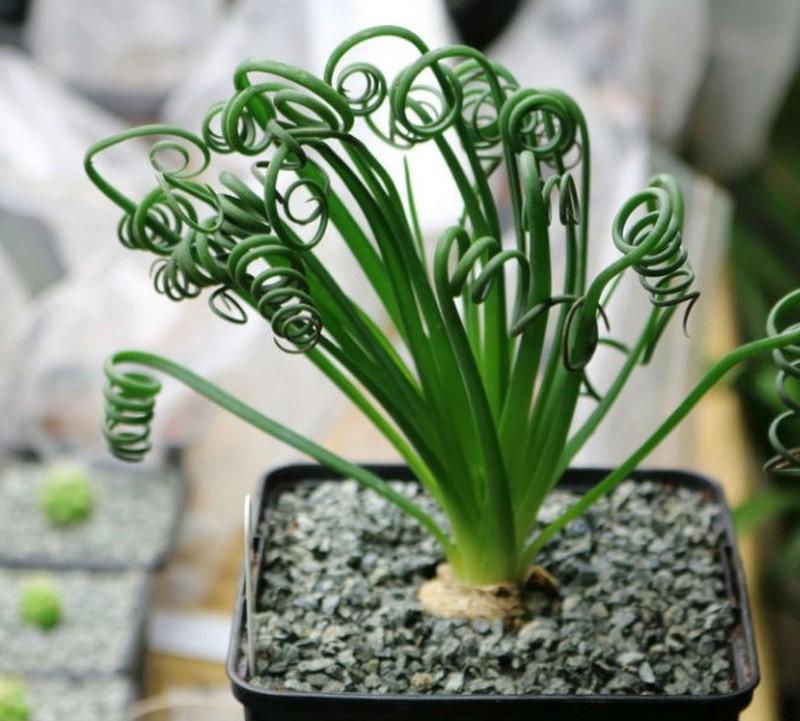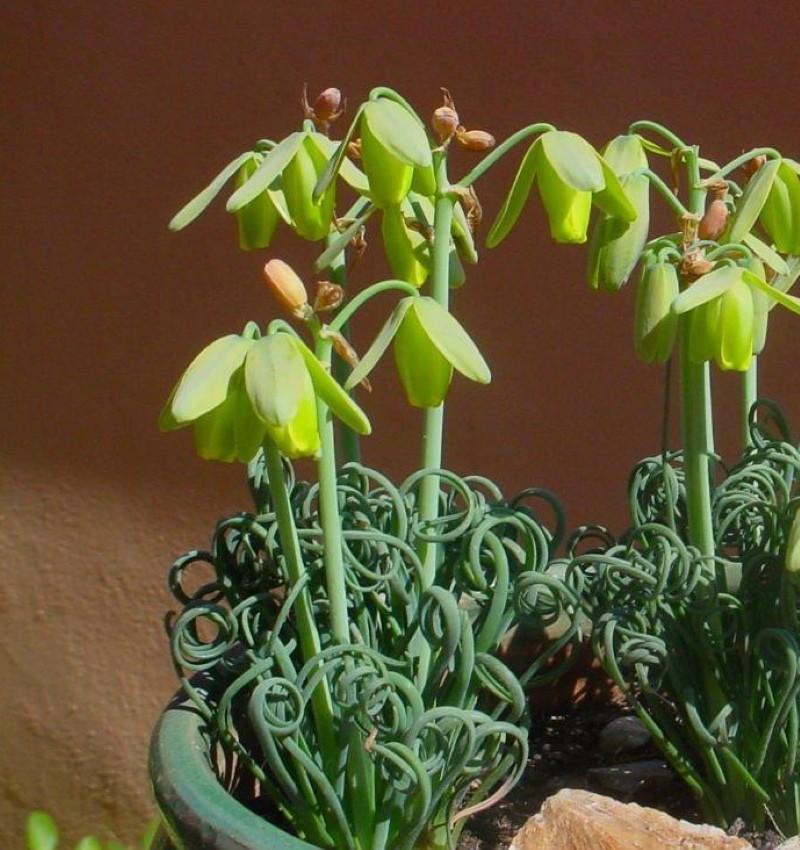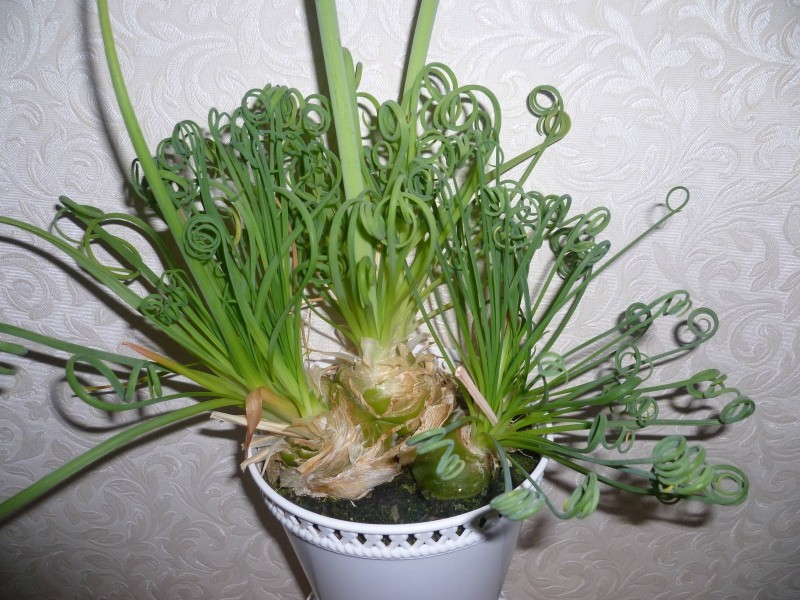Curly miracle - spiral albuka, features of development and care
 If most bulbs are grown for their gorgeous flowering, then this plant's buds are simply lost against the background of the original leaves. Albuka spiral will surprise you both with its appearance and persistent character, because it is not in vain that it belongs to succulents. It would seem, what does the bulbous representative have to do with succulents? But it is precisely this belonging to the most unpretentious crops that explains the appearance of the plant. In its homeland, in hot Africa, the albuca learned to survive in drought precisely thanks to the bulb and the ability of the leaves to curl. By reducing the evaporation area, the plants thus retain precious moisture. And they acquire a very decorative look, which makes the albuka a welcome guest on our windowsills. Decorative foliage, unpretentiousness and even flowering, albeit modest - this is what makes an albuka attractive for flower growers.
If most bulbs are grown for their gorgeous flowering, then this plant's buds are simply lost against the background of the original leaves. Albuka spiral will surprise you both with its appearance and persistent character, because it is not in vain that it belongs to succulents. It would seem, what does the bulbous representative have to do with succulents? But it is precisely this belonging to the most unpretentious crops that explains the appearance of the plant. In its homeland, in hot Africa, the albuca learned to survive in drought precisely thanks to the bulb and the ability of the leaves to curl. By reducing the evaporation area, the plants thus retain precious moisture. And they acquire a very decorative look, which makes the albuka a welcome guest on our windowsills. Decorative foliage, unpretentiousness and even flowering, albeit modest - this is what makes an albuka attractive for flower growers.
Spiral albuka

The first characteristic feature of the albuca itself is the root system - it is presented in the form of a rather large bulb with a diameter of up to 5 cm. The bulb has a slightly flattened shape and is painted white. Thin but fleshy leaves grow from its center, forming a dense rosette over time. They are even only in the lower part, closer to the bulb, while at the top they effectively twist in a spiral. The height of the rosette does not exceed 15 cm, but it is twisted. If the leaves are straightened, they become 2 times longer. In total, each rosette grows about two dozen leaves.
The hotter and lighter it is in the room, the more "spirals" swirl. Conversely, in a cool and shaded room, the album will only be slightly wavy.
 The second feature of the albuca is its vegetative period. At a time when many indoor flowers are dormant in winter, the bulbous succulent is actively growing foliage in order to bloom in spring. Its flowers are not particularly spectacular: small yellowish bells, collected in a loose inflorescence-brush. Although the peduncle itself is fleshy, gray in color, rather large, 2 times higher than the leaf rosette. And the flowers of some species of albuka emit a pleasant vanilla aroma. Closer to summer, when flowering ends, the bulb retires.
The second feature of the albuca is its vegetative period. At a time when many indoor flowers are dormant in winter, the bulbous succulent is actively growing foliage in order to bloom in spring. Its flowers are not particularly spectacular: small yellowish bells, collected in a loose inflorescence-brush. Although the peduncle itself is fleshy, gray in color, rather large, 2 times higher than the leaf rosette. And the flowers of some species of albuka emit a pleasant vanilla aroma. Closer to summer, when flowering ends, the bulb retires.
Features of growing albuka at home
 Given the tolerance of high temperatures and the ability to retain moisture, there will be no problems with planting and caring for the succulent. The main thing is to provide it with good lighting and temperature drops that are needed for flowering. In summer, this is not important, because the bulb does not grow, but already at the end of autumn it needs to be prepared for flowering. To do this, in the last decade of November, a pot with a plant is placed in a cool room with a temperature not exceeding 15 ° C heat. But this is not all: there must be a temperature difference of up to 5 ° between day and night for flower stalks to form.
Given the tolerance of high temperatures and the ability to retain moisture, there will be no problems with planting and caring for the succulent. The main thing is to provide it with good lighting and temperature drops that are needed for flowering. In summer, this is not important, because the bulb does not grow, but already at the end of autumn it needs to be prepared for flowering. To do this, in the last decade of November, a pot with a plant is placed in a cool room with a temperature not exceeding 15 ° C heat. But this is not all: there must be a temperature difference of up to 5 ° between day and night for flower stalks to form.
Otherwise, caring for the albuka is simple:
- abundant, but rare, watering during flowering and very poor - during dormancy;
- feeding twice a month with mineral fertilizers for succulents, but only during the growing season;
- transplanting the bulbs in the fall (at the end of the rest).
Albuca reproduces mainly vegetatively with the help of daughter bulbs. They are separated and seated during the autumn transplant. The seed method is also possible, but more troublesome. Seeds do not germinate well, seedlings grow for a long time, moreover, they do not retain varietal characteristics.